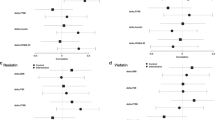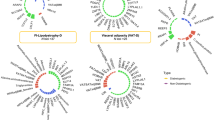Abstract
Objective:
Circulating leptin levels show a high degree of individual variability even after the main effect of body fatness is accounted for. We therefore wanted to determine the roles of variation in body composition, age, sex and polymorphisms of the UCP2 gene and promoter region on levels of circulating leptin.
Subjects:
One hundred and fifty Caucasian subjects, which represented a cross-section of the population from NE, Scotland, were recruited.
Measurements:
Body composition was measured using dual X-ray absorptiometry. Fasted circulating leptin, insulin, T3 and T4 levels were measured, and all individuals were genotyped for the UCP2 polymorphisms A55V, –866G>A and exon-8 ins/del.
Results:
The results indicate that circulating leptin was significantly related to sex and principle component (PC) scores representing overall adipose tissue mass and a second representing the contrast of central to peripheral bone mineral content. Residual leptin was associated with the A55V polymorphism (P< 0.001) explaining 11.3% of the residual variance. There was a marginal effect associated with exon-8 ins/del (P=0.045) explaining 4.4% of the residual variance in leptin. Loge transformed circulating fasting insulin was related to PC scores representing general adiposity and sex. Residual Loge insulin was associated with the A55V and exon-8 ins/del polymorphisms explaining 5.7% (P=0.015) and 5% (P=0.026) of the residual variation, respectively. The –866G>A polymorphism was not significantly associated with residual leptin or insulin. Leptin and insulin were significantly (P=0.007) correlated. Statistically removing the effect of insulin on leptin still showed association between leptin and A55V (P=0.002). Removing the effect of leptin on insulin, the A55V polymorphism was no longer significant (P=0.120). After accounting for the correlation between insulin and leptin, the exon-8 ins/del was no longer significant for residual leptin (P=0.119) or Loge insulin (P=0.252).
Conclusion:
These data suggest that the A55V polymorphism directly affected the levels of leptin but not via an effect on insulin.
This is a preview of subscription content, access via your institution
Access options
Subscribe to this journal
Receive 12 print issues and online access
$259.00 per year
only $21.58 per issue
Buy this article
- Purchase on SpringerLink
- Instant access to full article PDF
Prices may be subject to local taxes which are calculated during checkout




Similar content being viewed by others
References
Zhang YY, Proenca R, Maffei M, Barone M, Leopold L, Friedman JM . Positional cloning of the mouse obese gene and its human homolog. Nature 1994; 372: 425–432.
Flatt PR, Bailey CJ, Kwasowski P, Swanstonflatt SK . Contribution of hyperphagia to the development of metabolic abnormalities in obese hyperglycemic (Ob/Ob) mice. Nutr Rep Int 1989; 40: 1207–1215.
Pelleymounter MA, Cullen MJ, Baker MB, Hecht R, Winters D, Boone T et al. Effects of the obese gene product on body weight regulation in ob/ob mice. Science 1995; 269: 540–543.
Friedman JM, Halaas JL . Leptin and the regulation of body weight in mammals. Nature 1998; 395: 763–770.
Cone RD . The central melanocortin system and energy homeostasis. Trends Endocrinol Metab 1999; 10: 211–216.
Ahima RS, Prabakaran D, Mantzoros C, Qu DQ, Lowell B, MaratosFlier E et al. Role of leptin in the neuroendocrine response to fasting. Nature 1996; 382: 250–252.
Berthoud HR . A new role for leptin as a direct satiety signal from the stomach. Am J Physiol-Regulat Integr Comp Physiol 2005; 288: R796–R797.
Saladin R, Devos P, Guerremillo M, Leturque A, Girard J, Staels B et al. Transient increase in obese gene-expression after food-intake or insulin administration. Nature 1995; 377: 527–529.
Ahima RS, Prabakaran D, Flier JS . Postnatal leptin surge and regulation of circadian rhythm of leptin by feeding – implications for energy homeostasis and neuroendocrine function. J Clin Invest 1998; 101: 1020–1027.
Considine RV, Sinha MK, Heiman ML, Kriauciunas A, Stephens TW, Nyce MR et al. Serum immunoreactive leptin concentrations in normal-weight and obese humans. N Engl J Med 1996; 334: 292–295.
Rosenbaum M, Nicolson M, Hirsch J, Heymsfield SB, Gallagher D, Chu F et al. Effects of gender, body composition, and menopause on plasma concentrations of leptin. J Clin Endocrinol Metab 1996; 81: 3424–3427.
Ozata M, Ozisik G, Bingol N, Corakci A, Gundogan MA . The effects of thyroid status on plasma leptin levels in women. J Endocrinol Investigat 1998; 21: 337–341.
Kumar MV, Scarpace PJ . Differential effects of retinoic acid on uncoupling protein-1 and leptin gene expression. J Endocrinol 1998; 157: 237–243.
Lee KN, Jeong IC, Lee SJ, Oh SH, Cho MY . Regulation of leptin gene expression by insulin and growth hormone in mouse adipocytes. Exp Mol Med 2001; 33: 234–239.
Tan JTT, Patel BK, Kaplan LM, Koenig JI, Hooi SC . Regulation of leptin expression and secretion by corticosteroids and insulin – implications for body weight. Endocrine 1998; 8: 85–92.
Rayner DV, Trayhurn P . Regulation of leptin production: sympathetic nervous system interactions. J Mol Med- 2001; 79: 8–20.
Reseland JE, Haugen F, Hollung K, Solvoll K, Halvorsen B, Brude IR et al. Reduction of leptin gene expression by dietary polyunsaturated fatty acids. J Lipid Res 2001; 42: 743–750.
Brann DW, De Sevilla L, Zamorano PL, Mahesh VB . Regulation of leptin gene expression and secretion by steroid hormones. Steroids 1999; 64: 659–663.
Zhang HH, Kumar S, Barnett AH, Eggo MC . Intrinsic site-specific differences in the expression of leptin in human adipocytes and its autocrine effects on glucose uptake. J Clin Endocrinol Metab 1999; 84: 2550–2556.
Chung WK, Belfi K, Chua M, Wiley J, Mackintosh R, Nicolson M et al. Heterozygosity for Lep(ob) or Lepr(db) affects body composition and leptin homeostasis in adult mice. Am J Physiol-Regulat Integr Compar Physiol 1998; 43: R985–R990.
Farooqi IS, Keogh JM, Kamath S, Jones S, Gibson WT, Trussell R et al. Partial leptin deficiency and human adiposity. Nature 2001; 414: 34–35.
Butte NF, Hopkinson JM, Nicolson MA . Leptin in human reproduction: serum leptin levels in pregnant and lactating women. J Clin Endocrinol Metab 1997; 82: 585–589.
Carlsson B, Ankarberg C, Rosberg S, Norjavaara E, AlbertssonWikland K, Carlsson LMS . Serum leptin concentrations in relation to pubertal development. Arch Dis Childhood 1997; 77: 396–400.
Liu C, Grossmann A, Bain S, Strachan M, Puerner D, Bailey C et al. Leptin stimulates cortical bone formation in obese (ob/ob) mice. J Bone Mineral Res 1997; 12: 50.
Perez C, Fernandez-Galaz C, Fernandez-Agullo T, Arribas C, Andres A, Ros M et al. Leptin impairs insulin signaling in rat adipocytes. Diabetes 2004; 53: 347–353.
varez-Aguilar C, Mondragon-Jimenez LI, Ramirez-Enriquez J, Gomez-Garcia A, Paniagua-Sierra R, Amato D . Hyperleptinemia as a risk factor in obesity-related hypertension. Med Clin (Barc) 2004; 123: 766–769.
Perusse L, Rankinen T, Zuberi A, Chagnon YC, Weisnagel SJ, Argyropoulos G et al. The human obesity gene map: the 2004 update. Obes Res 2005; 13: 381–490.
Astrup A, Toubro S, Dalgaard LT, Urhammer SA, Sorensen TI, Pedersen O . Impact of the v/v 55 polymorphism of the uncoupling protein 2 gene on 24-h energy expenditure and substrate oxidation. Int J Obes Relat Metab Disord 1999; 23: 1030–1034.
Klannemark M, Orho M, Groop L . No relationship between identified variants in the uncoupling protein 2 gene and energy expenditure. Eur J Endocrinol 1998; 139: 217–223.
Yu X, Jacobs Jr DR, Schreiner PJ, Gross MD, Steffes MW, Fornage M . The uncoupling protein 2 Ala55Val polymorphism is associated with diabetes mellitus: the CARDIA study. Clin Chem 2005; 51: 1451–1456.
Esterbauer H, Schneitler C, Oberkofler H, Ebenbichler C, Paulweber B, Sandhofer F et al. A common polymorphism in the promoter of UCP2 is associated with decreased risk of obesity in middle-aged humans. Nat Genet 2001; 28: 178–183.
D'Adamo M, Perego L, Cardellini M, Marini MA, Frontoni S, Andreozzi F et al. The −866A/A genotype in the promoter of the human uncoupling protein 2 gene is associated with insulin resistance and increased risk of type 2 diabetes. Diabetes 2004; 53: 1905–1910.
Wang H, Chu WS, Lu T, Hasstedt SJ, Kern PA, Elbein SC . Uncoupling protein-2 polymorphisms in type 2 diabetes, obesity, and insulin secretion. Am J Physiol Endocrinol Metab 2004; 286: E1–E7.
Sesti G, Cardellini M, Marini MA, Frontoni S, D'Adamo M, Del GS et al. A common polymorphism in the promoter of UCP2 contributes to the variation in insulin secretion in glucose-tolerant subjects. Diabetes 2003; 52: 1280–1283.
Fritsche A, Thart LM, Dekker JM, Machicao F, Heine RJ, Haring HU et al. Variability in insulin secretion in carriers of a common-866G/A polymorphism in the promoter of UCP2 in non-diabetic subjects. Diabetes 2004; 53: A271.
Ji Q, Ikegami H, Fujisawa T, Kawabata Y, Ono M, Nishino M et al. A common polymorphism of uncoupling protein 2 gene is associated with hypertension. J Hypertens 2004; 22: 97–102.
Johnstone AM, Murison SD, Duncan JS, Rance KA, Speakman JR . Factors influencing variation in basal metabolic rate include fat-free mass, fat mass, age, and circulating thyroxine but not sex, circulating leptin, or triiodothyronine. Am J Clin Nutr 2005; 82: 941–948.
Marti A, Corbalan S, Forga L, Martinez-Gonzalez MA, Martinez JA . Higher obesity risk associated with the exon-8 insertion of the UCP2 gene in a Spanish case–control study. Nutrition 2004; 20: 498–501.
Walder K, Norman RA, Hanson RL, Schrauwen P, Neverova M, Jenkinson CP et al. Association between uncoupling protein polymorphisms (UCP2–UCP3) and energy metabolism/obesity in Pima Indians. Hum Mol Genet 1998; 7: 1431–1435.
Dalgaard LT, Pedersen O . Uncoupling proteins: functional characteristics and role in the pathogenesis of obesity and type ii diabetes. Diabetologia 2001; 44: 946–965.
Cassell PG, Neverova M, Janmohamed S, Uwakwe N, Qureshi A, McCarthy MI et al. An uncoupling protein 2 gene variant is associated with a raised body mass index but not Type II diabetes. Diabetologia 1999; 42: 688–692.
Ur E, Morash B, Wilkinson M . Nutrient and insulin regulate leptin gene expression in the hypothalamus. Diabetes 2001; 50: A373–A374.
Poitout V, Rouault C, Guerre-Millo M, Reach G . Does leptin regulate insulin secretion? Diabetes Metab 1998; 24: 321–326.
van Harmelen V, Reynisdottir S, Eriksson P, Thorne A, Hoffstedt J, Lonnqvist F et al. Leptin secretion from subcutaneous and visceral adipose tissue in women. Diabetes 1998; 47: 913–917.
Hayashi T, Boyko EJ, Leonetti DL, McNeely MJ, Newell-Morris L, Kahn SE et al. Visceral adiposity is an independent predictor of incident hypertension in Japanese Americans. Ann Internal Med 2004; 140: 992–1000.
Kristensen K, Pedersen SB, Richelsen B . Interactions between sex steroid hormones and leptin in women. Studies in vivo and in vitro. Int J Obes Relat Metab Disord 2000; 24: 1438–1444.
Langin D . The role of uncoupling protein 2 in the development of type 2 diabetes. Drugs Today 2003; 39: 287–295.
Maestrini S, Podesta F, Di Blasio AM, Savia G, Brunani A, Tagliaferri A et al. Lack of association between UCP2 gene polymorphisms and obesity phenotype in Italian Caucasians. J Endocrinol Invest 2003; 26: 985–990.
Acknowledgements
We are grateful to the Scottish Executive Environment and Rural Affairs Department for funding.
Author information
Authors and Affiliations
Corresponding author
Rights and permissions
About this article
Cite this article
Rance, K., Johnstone, A., Murison, S. et al. Plasma leptin levels are related to body composition, sex, insulin levels and the A55V polymorphism of the UCP2 gene. Int J Obes 31, 1311–1318 (2007). https://doi.org/10.1038/sj.ijo.0803535
Received:
Revised:
Accepted:
Published:
Issue date:
DOI: https://doi.org/10.1038/sj.ijo.0803535
Keywords
This article is cited by
-
UCP2, a mitochondrial protein regulated at multiple levels
Cellular and Molecular Life Sciences (2014)
-
Association between UCP2A55V polymorphism and risk of cardiovascular events in patients with multi-vessel coronary arterial disease
BMC Medical Genetics (2013)
-
Genes for Elite Power and Sprint Performance: ACTN3 Leads the Way
Sports Medicine (2013)
-
A common polymorphism in the promoter of UCP2 is associated with obesity and hyperinsulenemia in northern Indians
Molecular and Cellular Biochemistry (2010)
-
Polymorphisms of the FTO Gene Are Associated With Variation in Energy Intake, but not Energy Expenditure
Obesity (2008)



